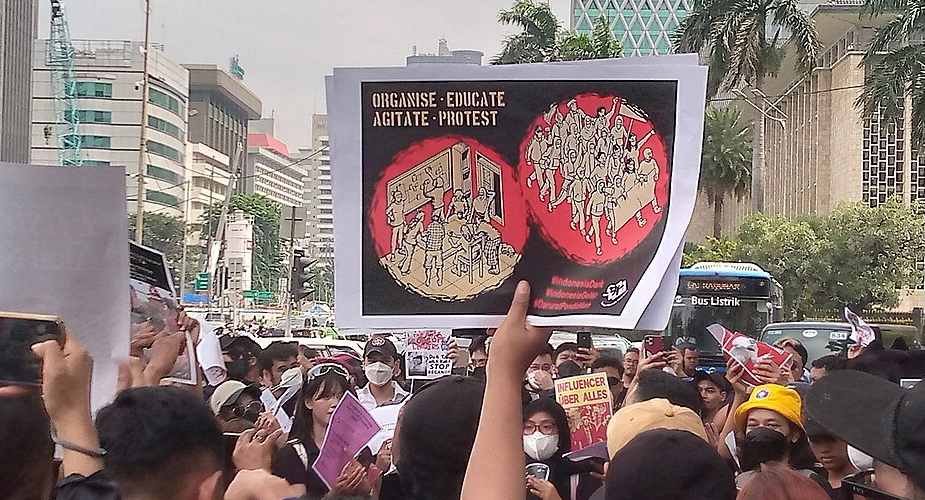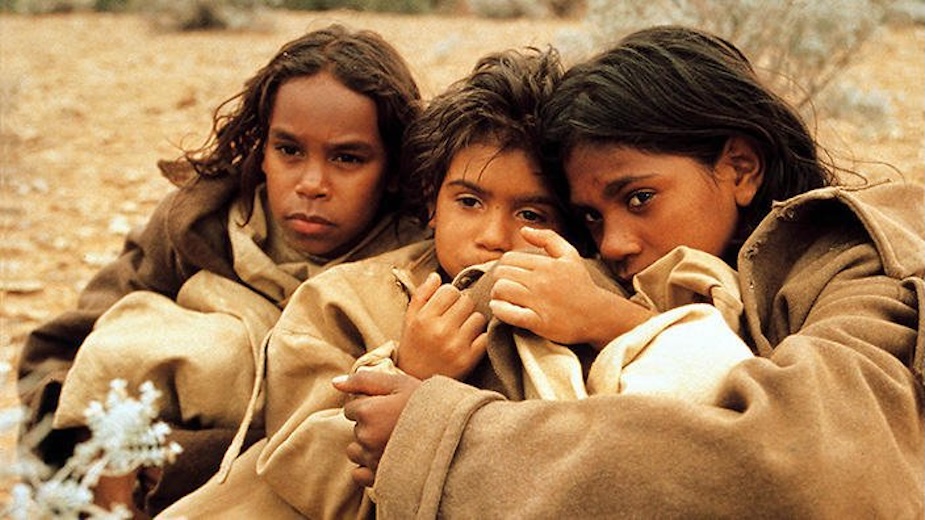Missionaries and the military co-operate in converting the Asmat to Christianity.
Astrid de Hontheim
People often view the churches in Papua as a source of support and protection for Papuans against abuse by the Indonesian military, as they were in East Timor before independence. The history of Christian conversion of the Asmat in Papua shows that this was often — but not always — the case. Over the last fifty years, Christian missionaries often worked together with the authorities, first the Dutch colonial state and later the Indonesian military, to ‘civilise’ the Asmat.
Approximately 65,000 Asmat people live in the marshy swamps on the south coast of Papua. In 1938, the first permanent Dutch post in the Asmat region was established in Agats, though it shut during World War II. The first missionary to arrive was Gerard Zegwaard of the Catholic Sacred Heart Order in 1953. The Sacred Heart mission was joined by evangelical missionaries (TEAM) in 1955 and the American Crosier fathers and brothers in 1958. In addition to proselytising, Catholic missionaries were active in the area of cultural preservation, while the Protestant missionaries mainly focused on medicine and linguistics.
Missionary activity under the Dutch
In the 1950s and 1960s, the Asmat were forced to give up traditional rituals — those who did not co-operate were arrested — which both the Dutch and Indonesian authorities and missionaries viewed as inspired by ‘satanic’ beliefs. During this period, many Asmat felt that by converting to Christianity, they could avoid suffering such insults, receive more respect and be seen as modern. Some Asmat believed that as Christians they would enjoy the same worldly goods as the missionaries.
Dutch colonial authorities felt conversion to Christianity would restrain violent confrontation triggered by the establishment of army posts. Under Dutch colonial rule, in areas where the Asmat used bows and arrows to keep away foreigners, the missionaries often proved to be more intrepid than the Dutch soldiers. (This was also the case under Indonesian rule.) As the group which had ‘first contact’, missionaries were considered to have a ‘pacifying’ effect. Both churches and the colonial administration put pressure on south coast Papuan societies to end head-hunting, cannibalism and polygamy. Dutch colonial police shot at canoes laden with warriors ready to set out on a raid. In the first decade after contact, the Asmat people remained in awe of these rifles and guns.
Asmat under Indonesian rule
Since Papua’s incorporation into Indonesia in 1963, the conversion of the Asmat to Christianity has also been affected by Indonesia’s laws relating to religion. In 1965 President Sukarno issued a decree requiring that all Indonesian citizens belong to one of five official religions, including Catholicism and Protestantism, a law which continues until the present with minor alterations (see the article by Bush in this edition). All Indonesian citizens must possess identity cards (KTP), stating their religion.
Since 1965, people who do ‘not yet have a religion’ can be suspected of being communists. This also contributed to some Papuans, though not the Asmat, asking missionaries to convert them to Christianity.
In 1978 the Minister of Religion issued two decrees which forbade proselytising among followers of official religions. Expatriate missionaries were denied work permits if their work was mainly evangelism. The use of material incentives to induce conversion — a practice often seen to produce ‘tobacco Christians’ — was banned. Despite this, missionaries among the Asmat continued to be tolerated, in many cases actively supported, by the military. This was because their missionary work was among so-called ‘animists’ — people without an ‘official religion’ — and therefore complementary to the Indonesian government’s aims.
In line with Suharto’s New Order policies, the military in Asmat began ‘the reform’ for ten years from 1965–1975. They established government posts in remote areas, leading to the spread of a generic ‘Indonesian’ way of life and progressively supplanting local customs. Large-scale Javanese transmigration, begun under Sukarno in 1963 and continued under Suharto, also contributed to cultural standardisation. Papuans were resettled into villages — not traditional social groupings — to control them more easily. This assisted in the government’s efforts to make villagers wear clothes and placed them under the authority of a village chief (kepala desa). In the resettlement process, hunters and gatherers were encouraged to raise cattle, grow vegetables and become involved in the market economy.
Contacts between Papuans and other Indonesians are still sometimes problematic, with the latter sometimes referring to Papuans as ‘backward’ (terbelakang) or ‘not yet developed’ (belum maju). At Agats, the major Asmat urban centre, several military officers told me during my stays in 2001 and 2004 that they were dedicated to the Papuans’ well-being. They claimed that without a religion — they do not consider traditional beliefs to be religions — the Papuans are unable to manage themselves without killing each other or having sex with multiple partners. The military focus on the hygiene and clothing of Papuans: their food (eating rice, not sago and pork); the discarding of traditional ornaments and multiple wives; and conversion to Christianity. In this context, the military see being a Christian as humanising (the Indonesian word ‘manusia’ is often used), as opposed to being ‘people of the forest’ (orang hutan) or savages.
In many cases, the Indonesian government’s and the missionaries’ aims coincided in their struggle against nomadism and their efforts to bring modernity to remote areas. To help the Asmat ‘modernise’, Crosier missionaries employed the Asmat in socio-economic development projects and coaxed them into attending training courses (kuperda) to become government-appointed village chiefs, although with limited success. Some missionaries noticed that the traditional Asmat practice of sharing everything could progressively be eliminated by teaching the Asmat competitive behaviour and sport.
Particularly during the 1960s and 1970s, missionaries enforced a number of Indonesian government orders, which coincided with their own moral stances. They often reported men involved in head-hunting or one night marriages (known as ‘wife exchange’) to Indonesian authorities and the men were arrested. In return, the Indonesian authorities tried to get people to go to church and mission schools. Some young boys were taken away by the military, against their parents’ wishes, to be educated at a Sacred Heart boarding school. From about 1964 to 1968 the Indonesian government prohibited activities which were seen to be connected to head-hunting. Dancing, drumming, wood carving, celebrations and the building of ritual men’s houses were forbidden. Whereas some Catholic missionaries co-operated with the authorities, Protestant missionaries claimed in 2005 and 2006 that they had been unaware of such a prohibition in the 1960s.
Catholic missionaries also became involved in political issues. The Ayam Revolt in 1974 and 1975 took place in the village of Ayam in the Asmat region, where for many years there had been fierce resistance against intense military and Christian (both Catholic and Protestant) control. The revolt began when Asmat men were beaten by police for refusing to fell lumber for a logging company, because they had not been paid for previous work. Around this time, a number of Ayam villagers, involved in an internal village conflict, killed 29 other Asmat men, using traditional — and forbidden — head-hunting methods. They then fled to the jungle to escape police punishment. Only when the bishop, Alphonse Sowada, spent time persuading them, did the villagers finally agree to go back home.
Preservation of religion and culture
After the nomination of Alphonse Sowada as bishop in 1969, Catholic missionaries showed more tolerance of cultural practices. The Crosier brothers, who had anthropological training and were influenced by the more liberal philosophy of Vatican II (1962–1965), aimed to preserve Asmat culture. They had become aware that the culture of the Asmat could be forgotten in less than a generation. They recorded the myths of the Asmat, publishing dozens of texts. They decorated churches with locally-meaningful cultural objects and designs and founded museums with Asmat collections in Agats in 1973 and in Shoreview, Minnesota, in 1994. In 1983, the Crosiers initiated an annual art auction, held in Agats, for primitive-art dealers. In 2003, Alphonse Sowada depicted the Catholic missionaries’ efforts as a ‘culture rescue’. The Crosiers’ approach influenced the Indonesian government, which subsequently allowed the Asmat to continue carving and to maintain aspects of culture such as the men’s houses, where the carvings were made. Sowada also went to Jakarta to argue for the Asmat’s rights to fair salaries and ownership of their forests. While Protestant missionaries were not interested in preserving culture, they made the Bible available to the Asmat, translating it into four Asmat languages.
Over the last ten years, the influence of the church has been waning. Most expatriate missionaries have left. Four Asmat pastors share the leadership of Protestant churches, but there are no Asmat priests, and people complain that Indonesian priests do not behave like the American priests did. Only a minority of Asmat regularly attend church and Asmat people increasingly prefer to marry in a traditional Asmat wedding ritual than the Christian one. In coastal areas, two families converted to Islam in 2004. Nevertheless, discussions with the Asmat people indicate that they are now generally happy with the presence of churches scattered in the Asmat territory, indicating both the Asmat people and the church have changed.
Astrid de Hontheim (asdehont@ulb.ac.be) is writing a PhD about missionaries among the Asmat at the Université Libre de Bruxelles and the Université de Provence.











